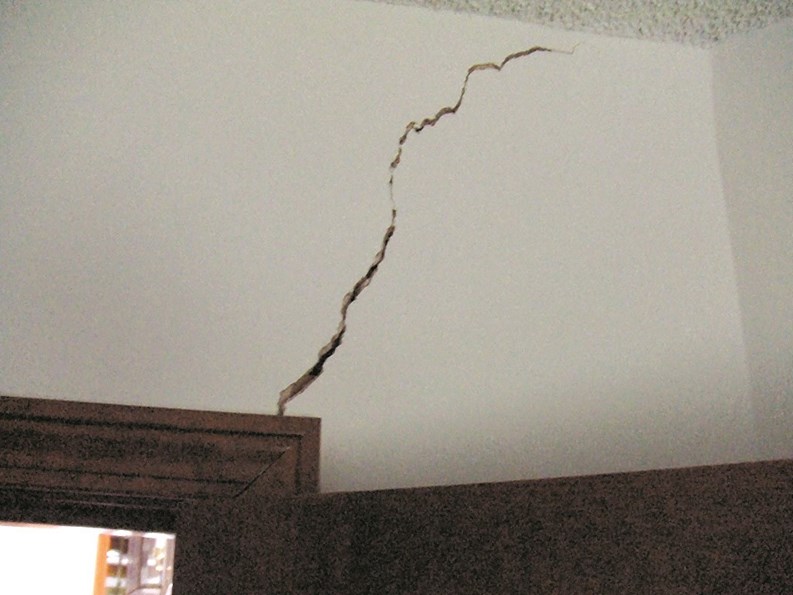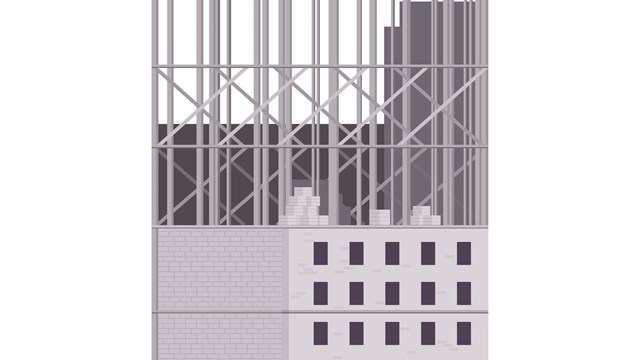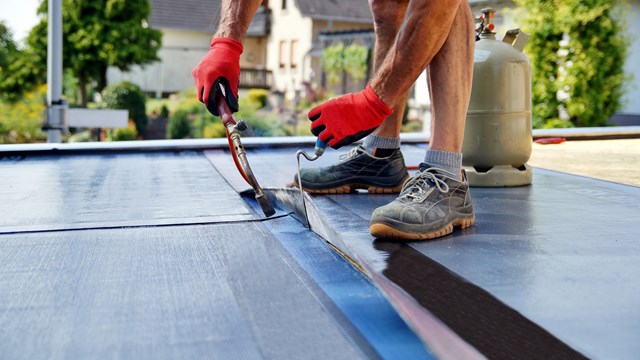Many people believe in the ethos of 'reduce, reuse, and recycle'—they buy vintage clothing, pre-owned cars, or refurbished electronic equipment. But most of us also like brand new things, including homes. And with markets across the country rebounding from the economic meltdown of the recession, new homes are becoming an option for more people and the lure of WiFi, designer name appliances and other state-of- the-art finishes can’t be ignored.
Living in shiny, fresh-out-of-the-box construction sometimes comes with problems, however; leaks in condo units, mechanical problems, insufficient noiseproofing, and other issues. While it might be better if every buyer could purchase a 2-year-old, already lived-in unit with the creaks worked out, real estate is often about timing as much as it is about location—so you buy when you can and when the market is right. If you’re buying new, it pays to take what steps you can to insure that the unit you're purchasing is as close to perfect as it can be. Caveat emptor isn’t just an adage to remind buyers to be careful. When the thing you’re buying is also where you’ll be living and likely represents your single biggest investment, naturally you want to protect that investment by every possible means. Ensuring your new home is in top shape before you move in is a good place to start.
What's a Defect?
New Jersey's Division of Consumer Affairs defines a "major structural defect" as "any actual damage to the load bearing portion of the home, including consequential damages, damage due to subsidence, ("sinking," in other words – ed.) expansion, or lateral movement of the soil—excluding movement caused by flood or earthquake—that affects its load-bearing function and that vitally affects or is imminently likely to vitally affect use of the home for residential purposes."
The New Home Warranty and Builders' Registration Act (NHWA) is a New Jersey-specific program enacted in 1977 that requires a builder to register with the state of New Jersey before starting construction of any new home. It also requires the builder to register with the state before offering a warranty on any new home bought or sold in New Jersey. According to the DCA, "Under the New Home Warranty Act…during the first year of a new home's warranty, warranty coverage extends to defective systems, workmanship, materials, plumbing, electrical and mechanical systems, appliances, fixtures, and equipment, and major structural defects. From the commencement date of the warranty up to two years from that date, the mechanical, electrical, and plumbing systems and major structural defects are covered. The builder is responsible for warranty coverage during the first two years. During the third through tenth years of coverage, only major structural defects are covered."
The NHWA defines construction standards for the first two years after a home is built. During that period, the warranty focuses on all aspects of the construction, and for the remaining eight years applies to all the major structural elements. In all cases, predefined standards are established as to what constitutes structural adequacy or inadequacy. Of course, disputes can easily arise if the builder and the customer don't immediately agree that there's a construction defect that needs correction. The building owner has the option of electing dispute resolution in the context of the warranty, or going to court.
Around the time the NHWA was created, the state also adopted a statewide, uniform construction code to be administered by officials licensed from the state, not the locality. In any new development, a series of inspections must be carried out by these licensed officials to examine all the major components of the project. The first inspection is made when the foundation is put in. The next inspection may be made when the roof assembly is built, and so on.
Finding Trouble Spots
Ask any real estate broker, attorney, contractor or developer about construction problems on new residential buildings, and you’ll likely get a different answer from each professional. But in the view of many pros, problems with construction often start at the builder/developer nexus.
Air and water leaks from roofs, terraces, bricks or windows are probably the single biggest complaint in newly constructed residential buildings, followed by insufficient coating on the roof, and incorrectly-sized boilers that are too weak for the building’s needs. Having too few elevators installed in a building community also can be a problem in some new structures. Sometimes the new buildings lack adequate soundproofing, or the soundproofing was improperly installed. Leaks, and lack of soundproofing between floors and walls, are two of the most common problems in new construction. Non-compliance with building codes, such as insufficient fire-stopping material, also can be problematic.
It’s a common refrain among engineers and other real estate professionals that construction is done so quickly and on the cheap nowadays, the suffering quality isn’t hard to spot. Sometimes in newly constructed residential buildings these days, architectural details of the building are not as they were sold to be. The developer or contractor didn’t do the job right, omitting some items or substituting one element for another of lesser quality or lower design standard. And while many people complain about the lack of craftsmanship in residential buildings these days, saying that way back when, the buildings were built much better, is only partly true. Seventy or more years ago, residential buildings weren’t built as hastily as some are now. It could’ve been a different mindset, or maybe cheaper labor and materials, or perhaps a bit of both.
On the other hand, the regulations governing building construction are much more exact than they were a few generations ago—so in a sense, residential structures are built better. The profit margins are tighter for some developers, while others just may be greedier. And increasingly complex building codes don't always lead to improved oversight of construction projects, say the pros.
“The problem stems from the fact that nobody’s watching the construction as it‘s happening,” says Donald Brenner, a shareholder attorney who heads the Construction Litigation Group at the law firm of Stark & Stark in Lawrenceville. "I’m talking about EIFS—exterior installation and finish systems.”
For example, the application of stucco and installation of brick wall systems should be certified by independent, third party inspectors, who are trained to determine if the work was done correctly. Unfortunately, developers and contractors are motivated to complete the project as soon as possible to benefit their own bottom lines, so they often have little incentive to slow down the project and compare actual specifications of the job to the work being done.
And if the sponsor is the culpable one for shoddy construction, remember that he’s a guy who wants to get his money and get out ASAP. Problems with shoddy construction, though, might not be revealed until years later. But that doesn’t mean windows don’t have to open and close properly, and that they're allowed to leak.
Removing Sale Obstacles
The fact is, a buyer could view unfinished construction in his or her apartment to be a hindrance to closing the sale. After you move into the unit, you’re at the mercy of the developer or sponsor—and many create Limited Liability Corporation (LLC) partnerships with the intention of making their money on the building and moving on when their own investment plan in the project is complete. This means that once that sponsor has sold all of their stake in the building, they can claim to not have any assets to pay for repairs to the structure. It makes getting repaid for having to get this sort of work done quite difficult.
So do your homework. The Offering Plan of any new development will list the standard of construction to be achieved, and will have a certification from the sponsor and architect that there’s no misrepresentation. The responsibility for repairing shoddy work should be detailed in the plan’s punch-list, and you should familiarize yourself with the various items that may be involved.
“I would definitely recommend a design professional to inspect it, and then look over the overall project site for problems that might foreshadow a problem with a particular unit,“ says Frank T. Araps, a member attorney with Herold Law, P.A, a law firm in Warren. “It's an expenditure, but I think it's well worth the investment. These types of investments are one of the largest investments a typical homeowner will make; it's their dwelling. But no question, I would recommend a design professional to do that.”
Most legal experts agree that it's better to get the extra work out of the way early on, via inspection and negotiation, before it turns into a job no one wants to do. Knowing what to look for in a co-op or condo unit—what you need in the space, as well as what obvious defects it has—is almost as important as understanding your price point. And knowing what signs of shoddy construction look like should be as apparent as knowing how close you want to live to the park. Obvious things, like water stains on ceilings or by windows, strong drafts, or incomplete or unfinished items like woodwork, etc., should never be ignored, no matter what a hard-sell broker may have you believe.
The appearance of some bad work, like a poorly installed exterior façade, requires a trained eye to spot. Stucco, stone and other cladding systems need holes at the bottom to allow water to drain out, otherwise the trapped water will damage the facade. Flashing should be installed properly, too, and most windows and doors should have it, at the sill and at the head of the window. It’s not just correct; it’s required by the building code.
Legally Speaking
The legal ramifications of a construction defect could be far-reaching. Since the condo association has the legal responsibility to fix common elements, problems with those common spaces could become a lawsuit the association finds itself forced to wage.
“One big problem is when the association doesn’t have money to hire a lawyer like me,” says Brenner, who represents such clients on a contingency basis. “We win by collecting from the insurance policies of the general contractor and sponsor, and subcontractors and design professionals.”
Often, the responsibility of shoddy construction in buildings being built too quickly lies with the builder, the contractor and the subs. Unit owners don’t get a pass, though.“The statute of limitations for instituting a lawsuit in New Jersey, with the developer for a construction, is six years,“ says Araps. “That six-year anniversary can be very problematic for many associations because oftentimes, that deadline is not monitored as rigorously as it should.”
And litigation for a latent defect (in other words, a hidden defect, or one not discovered during a reasonable inspection) can be commenced after this six-year period—so if you find the problem two or three years after the initial statute of limitations is up, you may still be able to take action. If the construction took place over 10 years ago, however, an even stricter "statute of repose" comes into play and limits your ability to seek legal action. "Once the statute of repose kicks in, you can't sue for any reason," explains David Hutt, a partner at the Woodbridge-based law firm of Hutt & Shimanowitz, P.C., "even if you didn't know about the defect."
When hiring an engineer to inspect your future home, have them inspect the place at the start of construction, when the place is one-quarter built, and once again when the construction is complete. For $1,000 or less in engineer’s fees, you could save yourself tens of thousands of dollars in repairs. If a buyer already has moved into a new building and then begins having leaks or other problems with construction defects, the owner should first ask the developer to fix it. If that approach fails, they may need to hire a real estate attorney and the best engineer they can to fight the developer.
Attorneys, engineers and home inspection pros will help you spot potential problems in your soon-to-be new condo, and in doing so they’ll help you avoid future problems. With their assistance, you can be certain that the deal you’re signing when you buy your place is exactly what you need. But, at the end of the day, much of the onus falls on the risk of making an investment. “Owners need to be diligent, and they need to be mindful that they have to do their inspections because what would have been disclosed by a reasonable inspection may not be actionable,” says Araps
Jonathan Barnes is a freelance writer and a regular contributor to The New Jersey Cooperator.







Leave a Comment